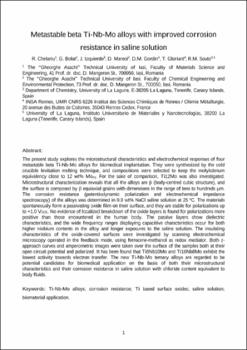Metastable beta Ti-Nb-Mo alloys with improved corrosion resistance in saline solution
Fecha
2014Resumen
The present study explores the microstructural characteristics and electrochemical responses of four metastable beta Ti-Nb-Mo alloys for biomedical implantation. They were synthesized by the cold crucible levitation melting technique, and compositions were selected to keep the molybdenum equivalency close to 12 wt% Moeq. For the sake of comparison, Ti12Mo was also investigated. Microstructural characterization reveals that all the alloys are β (body-centred cubic structure), and the surface is composed by β equiaxial grains with dimensions in the range of tens to hundreds μm. The corrosion resistance (potentiodynamic polarization and electrochemical impedance spectroscopy) of the alloys was determined in 0.9 wt% NaCl saline solution at 25 ºC. The materials spontaneously form a passivating oxide film on their surface, and they are stable for polarizations up to +1.0 VSCE. No evidence of localized breakdown of the oxide layers is found for polarizations more positive than those encountered in the human body. The passive layers show dielectric characteristics, and the wide frequency ranges displaying capacitive characteristics occur for both higher niobium contents in the alloy and longer exposures to the saline solution. The insulating characteristics of the oxide-covered surfaces were investigated by scanning electrochemical microscopy operated in the feedback mode, using ferrocene-methanol as redox mediator. Both z-approach curves and amperometric images were taken over the surface of the samples both at their open circuit potential and polarized. It has been found that Ti8Nb10Mo and Ti16Nb8Mo exhibit the lowest activity towards electron transfer. The new Ti-Nb-Mo ternary alloys are regarded to be potential candidates for biomedical application on the basis of both their microstructural characteristics and their corrosion resistance in saline solution with chloride content equivalent to body fluids






